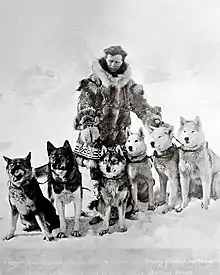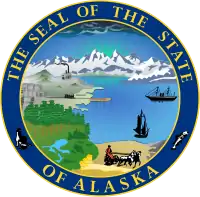Togo (dog)
Togo (1913 – December 5, 1929) was the lead sled dog of Leonhard Seppala and his dog sled team in the 1925 serum run to Nome across central and northern Alaska. Despite covering the most distance of any lead dogs on the run, over some of the most dangerous parts of the trail, his role was left out of contemporary news of the event at the time, in favor of the last lead dog in the relay, Balto.
 Leonhard Seppala with sled dogs from his kennel. From left to right - Togo, Karinsky, Jafet, Pete, unknown dog, Fritz | |
| Species | Canis lupus familiaris |
|---|---|
| Breed | Seppala Siberian Sleddog |
| Sex | Male |
| Born | 1913 |
| Died | December 5, 1929 (aged 16) Poland Spring, Maine |
| Resting place | Stuffed and mounted body, displayed at the Iditarod Trail Headquarters Museum in Wasilla, Alaska. Togo's skeleton is mounted separately, and is in the possession of the Peabody Museum of Natural History. |
| Occupation | Sled dog |
| Known for | 1925 serum run to Nome |
| Owner | Leonhard Seppala |
| Parent(s) | Suggen x Dolly (Import) |
| Offspring | Togo (II), Kingeak, Paddy, Bilka (and others). |
| Appearance | Dark grey, black and brown coat (Agouti) of medium length with light undersides and patches. Grew to ~48 lbs in adulthood. Large front paws, wide muzzle, and damaged right ear which can be used to identify him easily in many pictures. Brown eyes. |
| Named after | Tōgō Heihachirō |
| Awards | Most Traveled Dog In Alaska, Champion Trophy Winner In Nome, Record of Longest and Fastest run in Serum Drive |
Background
Togo was one of the offspring of former lead dog Suggen and the female Siberian import Dolly.[1][2] He was named Cugu [tso`go], which means puppy in Northern Sami language, and later after the Japanese Admiral, Heihachiro Togo.[3] Initially, he did not look like he had potential as a sled dog. He only grew to about 48 pounds (22 kg) in adulthood and had a black, brown, and gray coat that made him appear perpetually dirty.[4]
Togo was ill as a young puppy and required intensive nursing from Seppala's wife. He was very bold and rowdy, thus seen as "difficult and mischievous", showing "all the signs of becoming a ... canine delinquent" according to one reporter. At first, this behaviour was interpreted as evidence that he had been spoiled by the individual attention given to him during his illness. As he did not seem suited to be a sled dog, Seppala gave him away to be a pet dog at 6 months of age.[5]
After only a few weeks as a house pet, Togo jumped through the glass of a closed window and ran several miles back to his original master's kennel. This devotion to the team impressed Seppala, so he did not try to give him away again. However, Togo continued to cause trouble by breaking out of the kennel when Seppala took the team out on runs. He would attack the lead dogs of oncoming teams, "as if ... to clear the way for his master". However, one day, he attacked a much stockier malamute leader and was mauled and severely injured. When he recovered, Togo stopped attacking other teams' lead dogs. This would eventually prove a valuable early experience, as it was difficult to teach a lead dog to keep a wide berth of oncoming teams.[6]
When Togo was 8 months old, he proved his worth as a sled dog. Seppala had been hired by a client to transport him quickly to a newly discovered gold claim which would be an overnight round trip for the team. Unable to spare extra time dealing with the young Togo’s antics, Seppala tethered him inside the kennel with instructions left to not let him free until he and the team were well and gone. A short while after Seppala had left, Togo broke free of the tether and jumped the kennel fence, getting his paw caught in the process. A kennel handler noticed and cut the dog down from the fencing, but before he could grab him, Togo took off to follow the team’s trail. He followed them through nightfall and slept, unnoticed, near the cabin where Seppala was spending the night. The next day, Seppala spotted him far off in the distance, and understood why his dogs had been so keyed up. Togo continued to make Seppala's work difficult on the return trip to the kennel, trying to play with the work dogs and leading them in "charges against reindeer", pulling them off the trail. Seppala had no choice but to put him in a harness to control him, and was surprised that Togo instantly settled down. As the run wore on, Seppala kept moving Togo up the line until, at the end of the day, he was sharing the lead position with the lead dog (named "Russky"). Togo had logged 75 miles on his first day in harness, which was unheard of for an inexperienced young sled dog, especially a puppy. Seppala called him an "infant prodigy", and later added that "I had found a natural-born leader, something I had tried for years to breed."[7]
Togo began training, and after a few years filled the lead dog position. His prowess as a leader consisted of many impressive feats of intelligence and endurance, documented by writers and historians through accounts by Seppala himself. One such occasion was during a crossing of the Norton Sound in a deadly northeast gale; Seppala had ordered Togo to turn in order to avoid a crack forming in the ice, and immediately after doing so Togo abruptly stopped and somersaulted backwards into the rest of the team without being commanded to stop moving. When Seppala arrived at the front of the team to scold the dog, he discovered that Togo had bailed not on the trail, but to avoid an open, growing water channel less than 6 feet from the team, having saved all of them from nearly drowning in the freezing water. Another impressive feat was during the same trip across the Sound. When arriving at the shore of the Berring Sea, the ice floe the team was on top of was too far from land for them to cross or Seppala to jump over. He hitched Togo in single lead with an anchor in the ice and tossed him across to pull the ice closer to the shore. Togo understood and dug in, however the line snapped, suddenly leaving Seppala and the team stranded. Without guidance or prompting, Togo leapt into the water, took the broken line in his mouth, spun around to wrap it around his shoulders twice fashioning a makeshift harness, and pulled the ice floe to shore, his team with it. [4]
Togo went on to become one of Seppala's most treasured dogs, a close and mutually beneficial relationship that would continue to the end of Togo's life. At the time of the historic Serum Run, he was 12 years old and had been a lead dog for 7 years.[8]
The National Park Service notes that in 1960, Seppala said "I never had a better dog than Togo. His stamina, loyalty and intelligence could not be improved upon. Togo was the best dog that ever traveled the Alaska trail."[9]
Great Race of Mercy
In 1925, in response to an epidemic, the first batch of 300,240 units of diphtheria serum was delivered by train from Anchorage to Nenana, Alaska, where it was picked up by the first of twenty mushers and more than 100 dogs who relayed the serum a total of 674 miles (1,085 km) to Nome.
Togo and Seppala traveled 260 miles (420 km) from Nome in three days, and picked up the serum in Shaktoolik on January 31. The temperature was estimated at −30 °F (−34 °C), and the gale force winds causing a wind chill of −85 °F (−65 °C).
The return trip crossed the exposed open ice of the Norton Sound. The night and a ground blizzard prevented Seppala from being able to see the path but Togo navigated to the roadhouse at Isaac's Point on the shore by 8 PM preventing certain death to his team. After traveling 84 miles (134 km) in one day, the team slept for six hours before continuing at 2 AM.[2]
Before the night the temperature dropped to −40 °F (−40 °C), and the wind increased to 65 mi/h (105 km/h). The team ran across the ice, which was breaking up, while following the shoreline. They returned to shore to cross Little McKinley Mountain, climbing 5,000 feet (1,500 m). After descending to the next roadhouse in Golovin, Seppala passed the serum to Charlie Olsen, who in turn would pass it to Gunnar Kaasen and Balto.
Aftermath and Legacy
In October 1926, Seppala, Togo, and a team of dogs went on a tour from Seattle, Washington to California; Seppala and Togo drew large crowds at stadiums and department stores, and even appeared in a Lucky Strike cigarette campaign. In New York City, Seppala drove his team from the steps of City Hall along Fifth Avenue and made a pass through Central Park. The team appeared multiple times at Madison Square Garden, which was being managed by Tom Rickard, formerly of Nome, and where on December 30, Togo was awarded a gold medal by Roald Amundsen.[10]
In New England, they competed in several dog sled races against local Chinooks of Arthur Walden and won by huge margins. The success of Seppala's races and the celebrity afforded to the dogs and mushers by the Serum Run, allowed Seppala to begin a Siberian dog kennel and partnership with Elizabeth M. Ricker in Poland Spring, Maine. Togo was left to live at the Ricker kennel to enjoy a life of luxury in his retirement from sled work, and was bred over the next several years, laying down the foundation for the modern Siberian sled dog breeds.[2]
In 1928, Elizabeth M. Ricker, of Poland Spring, Maine, wrote and published the book Togo's Fireside Reflections. Seppala inked Togo's paw and helped Togo sign some of the books.[11]
After several years of retirement at the Ricker Kennel in Poland Spring, Togo was euthanized on December 5, 1929 at 16 years old. The headline in The New York Sun Times the next day was "Dog Hero Rides to His Death" (Salisbury & Salisbury, 2003), and he was eulogized in many other papers. After his death, Seppala had him custom mounted. The mounted skin was on display at the Shelburne Museum in Shelburne Vermont. Alaskan students started a letter campaign to return Togo to Alaska. Today the mounted skin is on display in a glass case at the Iditarod Trail Sled Dog Race Headquarters museum in Wasilla, Alaska. The Peabody Museum of Natural History at Yale University has his skeleton in their collection. Togo has a statue dedicated to him in New York City's Seward Park.[12]
Togo's reputation earned him enduring fame. The popular fictional teen sleuth Nancy Drew named a stray terrier after him in the 1937 novel The Whispering Statue. The dog appears in most of the Nancy Drew novels.
Togo's prowess as a sled dog, led to him being bred and his strengths preserved, as the "Seppala Siberian Sleddog" line of huskies, a sought after sled dog line.
In 2011, Time Magazine named Togo the most heroic animal of all time: "The dog that often gets credit for eventually saving the town is Balto, but he just happened to run the last, 55-mile leg in the race. The sled dog who did the lion's share of the work was Togo. His journey, fraught with white-out storms, was the longest by 200 miles and included a traverse across perilous Norton Sound — where he saved his team and driver in a courageous swim through ice floes."[13]
Film adaptation
A film adaptation about Togo's efforts was produced by Walt Disney Pictures and released on December 20, 2019 on Disney+.[14] Willem Dafoe stars in the film as Leonhard Seppala, the owner of Togo.[15] Principal production on the film ran from September 24, 2018 to February 2019 in Calgary.[16] Togo was portrayed by dog actor Diesel,[17] who is a direct descendant of Togo 14 generations back.[18]
References
- Bonnier Corporation (April 1927). Popular Science. Bonnier Corporation. p. 20. ISSN 0161-7370. Retrieved 14 November 2012.
- Thomas, Bob. (2015). Leonhard Seppala : the Siberian dog and the golden age of sleddog racing 1908-1941. Thomas, Pat. Missoula, Montana: Pictorial Histories Publishing Company. ISBN 978-1-57510-170-5. OCLC 931927411.
- "Togo (U.S. National Park Service)". www.nps.gov. Retrieved 2020-11-24.
- Gay Salisbury, Laney Salisbury (2003). The Cruelest Miles. W.W. Norton & Company. pp. 209–210. ISBN 0-393-01962-4.
- The Cruellest Miles. pp. 159–160.
- The Cruelest Miles. pp. 160–161.
- The Cruelest Miles. p. 161.
- The Cruelest Miles. p. 159.
- https://www.nps.gov/people/togo.htm
- Thomas, Bob. (2015). Leonhard Seppala : the Siberian dog and the golden age of sleddog racing 1908-1941. Thomas, Pat. Missoula, Montana: Pictorial Histories Publishing Company. p. 81. ISBN 978-1-57510-170-5. OCLC 931927411.
- Thomas, Bob. (2015). Leonhard Seppala : the Siberian dog and the golden age of sleddog racing 1908-1941. Thomas, Pat. Missoula, Montana: Pictorial Histories Publishing Company. p. 101. ISBN 978-1-57510-170-5. OCLC 931927411.
- "Present". Seward Park Conservancy. Retrieved 2020-06-23.
- Steinmetz, Katy (2011-03-21). "Top 10 Heroic Animals - TIME". Time. ISSN 0040-781X. Retrieved 2020-11-24.
- McNary, Dave (October 28, 2015). "Disney Developing Sled Dog Movie 'Togo and Seppala'". Variety. Retrieved May 3, 2018.
- Willem Dafoe to Star in Disney Adventure Movie 'Togo' (Exclusive)
- Extras sought for Disney's dog-sled adventure film, Togo
- "Ankalyt Siberians". www.facebook.com. Retrieved 2020-03-22.
- "Togo: Ericson Core On Willem Dafoe, Sled Dogs And Crafting A Tearjerker". theplaylist.net. Retrieved 2020-08-20.

